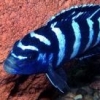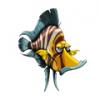Pseudotropheus Williamsi
Pictures

Male
Pseudotropheus Williamsi North Makonde

Female
Pseudotropheus Williamsi North Makonde
Description
In the aquarium they need a good stone setting with lots of caves. If you want to imitate nature a little, they should have a strong circulation, but this is not a necessity. The males are very territorial towards males of the same species, but other species it leaves alone. You should have 2-3 females to every male. If you have more than one male, one must be sure to have many caves. They have a reputation for being very bold, and they are hiding often.
Williamsi North Orange become more aggressive with age and should not be housed with calmer tank mates.
A little history:
Pseudotropheus williamsi found at Likoma Island, Mbenji Island, Painting Iceland and Chizumulu Island. Here it finds its food on open water. It consists to a large extent on plankton, but also invertebrates and insects that come floating through the water. It has been seen a few times eating of the sediment on the rocks. It lives in shallow water inside the rocky coasts.
It is one of the largest Pseudotropheus types. Males can reach up to 17 cm. Many call them Blue Lips as both males and females have blue lips.
Males have a very large territory, but it is only males of the same species which are being chased away. They do not eat much when they are in play mood because they're so busy taking care of their large territory. The male entices as soon as there is a female around it. The female carries the offspring around 3 weeks.
Their territory will only be defended against males of the same species, other cichlids are mostly allowed to be in the territory. They are not particularly difficult to get to breed in aquarium conditions. After 20-24 days the female releases her brood who loves shrimp.
Number of offspring
40-50
Cichlider, Malawi - Mbuna
Trade Name
Pseudotropheus Williamsi Tanzania, Pseudotropheus Williamsi North
Colours: Pseudotropheus Williamsi North Makonde
The male is light blue on the body that fade into a yellowish color towards the head. The female is yellow with black spots and blue lips and fins.
Colours: General
Males vary in color depending on which locality they come from. We know them mainly as dark, but with a nice blue or yellow color that covers most of the body, and with reddish fins. They all have yellow eggspots. All variants have blue lips. But as I said males variate with their looks depending on their locality. Example males from Chizumulu is very similar to Pseudotropheus socolodi with the same blue base color and black colors on the edge of the fins.
Females are actually pretty good looking also. They have a light ground color, but with a portion of the yellow contrasts. In addition, the black dots along the body and blue lips. Overall, P. williamsi unfortunately a reputation for very easy to throwing it's beautiful colors, as it is quite demanding to not be afraid in the aquarium.
Size Male
17
Size Female
15
Best Conditions
23°C
Max. temp
28°C
Min. pH
7.6
Max. pH
8.5
Min. aquarium
530L
Holding!;
Best with More Females then Males
Algies
Cichlidsticks
Crisp
Flakes
Edited by Malawi Freak, 07 June 2013 - 11:03 PM.













